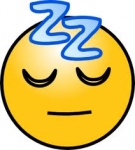Switching to Bi-Level - What to expect?
Switching to Bi-Level - What to expect?
Hi!
My sleep doctor is switching me to a bi-level machine starting tomorrow. After reviewing my 2 sleep study stats, I did better when they tried the bi-level.
What should I expect? Will I notice much of a difference in the actual sleep experience??
I think I will be getting this machine...
https://www.cpap.com/productpage/S9-VPA ... chine.html
My sleep doctor is switching me to a bi-level machine starting tomorrow. After reviewing my 2 sleep study stats, I did better when they tried the bi-level.
What should I expect? Will I notice much of a difference in the actual sleep experience??
I think I will be getting this machine...
https://www.cpap.com/productpage/S9-VPA ... chine.html
Re: Switching to Bi-Level - What to expect?
If you're not also switching to a significantly higher pressure I think you'll find the switch from the Autoset to VPAP will be very easy and will not feel significantly different. I made the same switch a year ago. The machine and menu operations are virtually identical so you'll already be very familiar with the new machine. I find the VPAP (mine is VPAP Auto) to be just a little easier to breathe with, something about how sensitively it follows my inhales and exhales. I think you'll be pleased.
_________________
| Machine: AirSense 10 AutoSet with Heated Humidifer + Aifit N30i Nasal Mask Bundle |
| Additional Comments: SleepyHead-now-OSCAR software on Mac OSX Ventura |
-
sawinglogz
- Posts: 400
- Joined: Mon Aug 27, 2012 12:53 pm
Re: Switching to Bi-Level - What to expect?
Think of it as the inverse of CPAP + EPR.
With CPAP + EPR, you're mostly at the higher ("constant") pressure, with a slight dip at the beginning of each exhalation. (The dip is 1-3 cmH2O depending on your EPR/flex setting.)
With bi-level, you're mostly at the lower (EPAP) pressure until it detects you inhaling, at which point it switches to the higher (IPAP) pressure during your breath.
It's not exactly the inverse, since bi-level will be at IPAP throughout your inspiration, where as EPR is just a brief drop at the beginning of your expiration, but it's a reasonably intuitive approximation.
The biggest challenges you might encounter are:
1) It might occasionally mistakenly think you're inhaling when you swallow, depending on the kind of pressure changes your swallowing creates. (This happens to me maybe 5% of the time now; I just blow out a little after swallowing which convinces it that I'm no longer trying to inhale.)
2) It might make mask leaks a little different than before. Now the higher pressure will be the exception rather than the rule, which can make adjusting your mask a little trickier. If you're on non-auto you might be able to use the mask fit feature, but you probably won't use that every time you go to bed. Also, the leaks can interact with the breath detection, since a leak looks like inhaling (at first), so it bumps up to IPAP, which makes the leak worse, and then it ramps up trying to maintain IPAP.
But neither of these causes me much disturbance. It'll just feel a little different for the first few days.
With CPAP + EPR, you're mostly at the higher ("constant") pressure, with a slight dip at the beginning of each exhalation. (The dip is 1-3 cmH2O depending on your EPR/flex setting.)
With bi-level, you're mostly at the lower (EPAP) pressure until it detects you inhaling, at which point it switches to the higher (IPAP) pressure during your breath.
It's not exactly the inverse, since bi-level will be at IPAP throughout your inspiration, where as EPR is just a brief drop at the beginning of your expiration, but it's a reasonably intuitive approximation.
The biggest challenges you might encounter are:
1) It might occasionally mistakenly think you're inhaling when you swallow, depending on the kind of pressure changes your swallowing creates. (This happens to me maybe 5% of the time now; I just blow out a little after swallowing which convinces it that I'm no longer trying to inhale.)
2) It might make mask leaks a little different than before. Now the higher pressure will be the exception rather than the rule, which can make adjusting your mask a little trickier. If you're on non-auto you might be able to use the mask fit feature, but you probably won't use that every time you go to bed. Also, the leaks can interact with the breath detection, since a leak looks like inhaling (at first), so it bumps up to IPAP, which makes the leak worse, and then it ramps up trying to maintain IPAP.
But neither of these causes me much disturbance. It'll just feel a little different for the first few days.
Re: Switching to Bi-Level - What to expect?
kaiasgram wrote:If you're not also switching to a significantly higher pressure I think you'll find the switch from the Autoset to VPAP will be very easy and will not feel significantly different. I made the same switch a year ago. The machine and menu operations are virtually identical so you'll already be very familiar with the new machine. I find the VPAP (mine is VPAP Auto) to be just a little easier to breathe with, something about how sensitively it follows my inhales and exhales. I think you'll be pleased.
I had the same experience as Kaiasgram. No problem with the switch at all.
_________________
| Mask: AirFit™ P10 Nasal Pillow CPAP Mask with Headgear |
| Humidifier: S9™ Series H5i™ Heated Humidifier with Climate Control |
| Additional Comments: P: 6/10 |
If only the folks with sawdust for brains were as sweet and obliging and innocent as The Scarecrow! ~a friend~
- ChicagoGranny
- Posts: 15081
- Joined: Sun Jan 29, 2012 1:43 pm
- Location: USA
Re: Switching to Bi-Level - What to expect?
What will your new settings be and what are your current settings?spmccord wrote:Hi!
My sleep doctor is switching me to a bi-level machine starting tomorrow. After reviewing my 2 sleep study stats, I did better when they tried the bi-level.
What should I expect? Will I notice much of a difference in the actual sleep experience??
I think I will be getting this machine...
https://www.cpap.com/productpage/S9-VPA ... chine.html
"It's not the number of breaths we take, it's the number of moments that take our breath away."
Cuando cuentes cuentos, cuenta cuántas cuentos cuentas.
Cuando cuentes cuentos, cuenta cuántas cuentos cuentas.
Re: Switching to Bi-Level - What to expect?
I will find out later this afternoon!
Re: Switching to Bi-Level - What to expect?
I use the mask fit every night. It's a good wY for me to know that I'm ready to sleep.
_________________
| Machine: AirCurve™ 10 VAuto BiLevel Machine with HumidAir™ Heated Humidifier |
| Mask: DreamWear Nasal CPAP Mask with Headgear |
| Additional Comments: EPAP 8, IPAP 14, PS 3.6 |
Re: Switching to Bi-Level - What to expect?
Ems, do you use any PS with your 6/9 setting or do you just use the S setting with no PS?ems wrote:kaiasgram wrote:If you're not also switching to a significantly higher pressure I think you'll find the switch from the Autoset to VPAP will be very easy and will not feel significantly different. I made the same switch a year ago. The machine and menu operations are virtually identical so you'll already be very familiar with the new machine. I find the VPAP (mine is VPAP Auto) to be just a little easier to breathe with, something about how sensitively it follows my inhales and exhales. I think you'll be pleased.
I had the same experience as Kaiasgram. No problem with the switch at all.
_________________
| Mask: Mirage Quattro™ Full Face CPAP Mask with Headgear |
| Additional Comments: 14/8.4,PS=4, UMFF, 02@2L, |
"Do or Do Not-There Is No Try"-"Yoda"
"We are what we repeatedly do,so excellence
is not an act but a habit"-"Aristotle"
DEAR HUBBY BEGAN CPAP 9/2/08
"We are what we repeatedly do,so excellence
is not an act but a habit"-"Aristotle"
DEAR HUBBY BEGAN CPAP 9/2/08
Re: Switching to Bi-Level - What to expect?
My CPAP setting was 14.
My Bi-level will be 17/13.
My Bi-level will be 17/13.
-
sawinglogz
- Posts: 400
- Joined: Mon Aug 27, 2012 12:53 pm
Re: Switching to Bi-Level - What to expect?
Did you use any EPR before? If so, what level?
If you were using EPR, I suspect your bi-level will feel like slightly more pressure. But given that this is the result of looking at your sleep study, the 13/17 is probably based on their measurements, so it's almost certainly worth starting there.
If you weren't using EPR, this will probably feel like less pressure except when you inhale.
If you were using EPR, I suspect your bi-level will feel like slightly more pressure. But given that this is the result of looking at your sleep study, the 13/17 is probably based on their measurements, so it's almost certainly worth starting there.
If you weren't using EPR, this will probably feel like less pressure except when you inhale.
Re: Switching to Bi-Level - What to expect?
I do have a question...
Does the machine respond to my breathing or does the machine try to dictate breathing to me??
I noticed more leaks last night with the Bi-level. I'll have to cinch up the straps tonight.
Does the machine respond to my breathing or does the machine try to dictate breathing to me??
I noticed more leaks last night with the Bi-level. I'll have to cinch up the straps tonight.
-
sawinglogz
- Posts: 400
- Joined: Mon Aug 27, 2012 12:53 pm
Re: Switching to Bi-Level - What to expect?
Unless they've turned on a backup timer, it responds to you. It can, however, get a little confused and switch to IPAP before you're really ready, lag a little bit so that you feel like you're fighting it, or sometimes get completely confused and switch to IPAP when you swallow. Blowing out (like you're clearing water out of your nose) will usually convince it that you're not inhaling.spmccord wrote:Does the machine respond to my breathing or does the machine try to dictate breathing to me??
Eventually the two of you will get in sync with your breathing pattern.
Make sure you're not having mouth leaks. Sometimes the change in pressure can overcome your usual resistance.I noticed more leaks last night with the Bi-level. I'll have to cinch up the straps tonight.
Re: Switching to Bi-Level - What to expect?
i generally find tightening the straps makes for more leaks. Look at fit instead. It took me 3 months to get consistently under the large leak line, and I think the biggest contributing factors were 1) relaxing 2) not trying to over-engineer my solution with too many creams, straps, pAds, etc 3) washing my face with soap before masking up 4) finding the right mask for my face-there IS one that's just perfect for you, you just have to keep trying!I noticed more leaks last night with the Bi-level. I'll have to cinch up the straps tonight.
_________________
| Machine: AirCurve™ 10 VAuto BiLevel Machine with HumidAir™ Heated Humidifier |
| Mask: DreamWear Nasal CPAP Mask with Headgear |
| Additional Comments: EPAP 8, IPAP 14, PS 3.6 |
Re: Switching to Bi-Level - What to expect?
I wouldn't worry about the transition, at all, if I were you. For me bi-level CPAP was a lifesaver as I could not tolerate constant CPAP. But it might require some adjustment in the beginning. For example, during my titration study they tried bi-level and it didn't work. Probably because they had me sleeping supine (way too many wires and sensors) and I can't sleep on my back, and with the higher pressures of bi-level, and being the very first time on a CPAP machine, it was very hard on me. But after struggling with constant pressure for a week or two, my doctor prescribed a bi-level and it took immediately. Normally bi-level is meant to make it easier on the patient; if your doctor thinks you need bi-level, I think you definitely will benefit from it.
I should also point out that there are many adjustments on your new machine to help you customize it to your needs. My observations are from the S8 version of that machine, but I'm sure the S9 has those and probably more. For example, you can set the rate of pressure increase (from very gradual to an abrupt hit; I like the latter); the sensitivity to inhalation (from the machine requiring a significant inhalation effort to trigger, to immediately cranking up the pressure upon the slightest hint of pressure change in your airways; I like the latter); the minimum and maximum durations at IPAP level, and so on. I recommend you obtain a clinician's manual and study those.
Good luck!
McSleepy
I should also point out that there are many adjustments on your new machine to help you customize it to your needs. My observations are from the S8 version of that machine, but I'm sure the S9 has those and probably more. For example, you can set the rate of pressure increase (from very gradual to an abrupt hit; I like the latter); the sensitivity to inhalation (from the machine requiring a significant inhalation effort to trigger, to immediately cranking up the pressure upon the slightest hint of pressure change in your airways; I like the latter); the minimum and maximum durations at IPAP level, and so on. I recommend you obtain a clinician's manual and study those.
Good luck!
McSleepy
_________________
| Machine: AirCurve™ 10 VAuto BiLevel Machine with HumidAir™ Heated Humidifier |
| Additional Comments: Previous machine: ResMed S9 VPAP Auto 25 BiLevel. Mask: Breeze with dilator pillows. Software: ResScan ver. 5.1 |
ResMed AirCurve 10 VAuto; Puritan-Bennett Breeze nasal pillow mask; healthy, active, middle-aged man; tall, athletic build; stomach sleeper; on CPAP since 2003; lives @ 5000 ft; surgically-corrected deviated septum and turbinates; regular nasal washes
-
sawinglogz
- Posts: 400
- Joined: Mon Aug 27, 2012 12:53 pm
Re: Switching to Bi-Level - What to expect?
Just to reiterate the point that everybody's different and what works for one person might not work for you:Jeannh wrote:3) washing my face with soap before masking up
For me, if I wash my face before bed, my face is too dry and the mask liner leaks! I actually need a little moisture for the mask liner to get a good seal.












